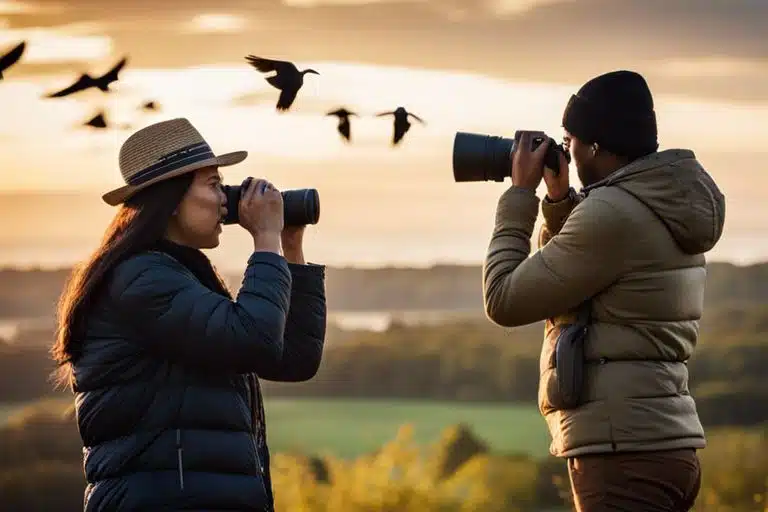Communities of birders around the world are increasingly turning to online platforms to share their sightings, log their observations, and connect with fellow enthusiasts. With the rise of new technology and tools, such as high-quality photography and DNA testing, birdwatching has become more accessible than ever before. However, the recent controversy surrounding a record-breaking birding achievement serves as a reminder of the importance of diligence and accuracy in the world of bird observation. As birders navigate the digital landscape in search of rare species and new discoveries, it is important to be aware of the potential pitfalls as well as the thriving communities that can enhance the birding experience.
Key Takeaways:
- Competitive Birding: The rise of online platforms has made birding a competitive sport, with birders striving to log rare sightings and break records like seeing over 10,000 bird species in the wild. This competition has sparked controversy and scrutiny within the birding community.
- Technology and Taxonomies: Advances in technology, such as digital cameras and AI, have revolutionized birdwatching by allowing for high-quality photos and easier species identification. Changes in bird taxonomies also impact the counting of bird species, with varying lists like the Clements Checklist and IOC World Bird List influencing the number of recognized species.
- Community and Collaboration: Despite the competitive nature of birding, the online birding community emphasizes teamwork, information sharing, and camaraderie. Birding is seen as a team sport, with birders supporting each other, sharing knowledge, and fostering relationships on trips and online platforms.
Birding Online Communities
Forums and Discussion Platforms
Some of the most popular online platforms for birders to connect and share their sightings, experiences, and knowledge include Surfbirds.com, BirdForum, and eBird. These forums serve as hubs for the birding community to discuss rare sightings, ask for identification help, and engage in friendly competitions. With the rise of technology and improved DNA testing, birdwatchers can now easily connect with fellow enthusiasts from around the world to collaborate and learn from each other’s experiences.
Social Media Groups and Hashtags
Any avid birder looking to engage with a larger online community can explore social media groups on platforms like Facebook and Twitter, using popular birding hashtags to join conversations and share their own sightings. These groups and hashtags offer a great way to stay updated on rare bird sightings, conservation efforts, and birding events. Whether you’re a beginner or an experienced birder, connecting with these online communities can enhance your birdwatching experience and provide valuable insights into the world of birding.
One of the key advantages of social media groups and hashtags is the real-time nature of information sharing. Birdwatchers can instantly post about their latest sightings, ask for help with identifications, and engage with a global community of fellow bird enthusiasts. These platforms help bridge the gap between birdwatchers across different regions and continents, fostering a sense of camaraderie and collaboration in the birding community.
To make the most of these online resources, birders can actively participate in discussions, share their own photos and stories, and contribute to citizen science efforts. By utilizing social media platforms and online forums, birders can make valuable connections, expand their knowledge, and contribute to bird conservation efforts on a global scale.

Digital Tools for Birders
Bird Identification Apps
If you’re new to birding or just want an easier way to identify the species you come across, bird identification apps are a game-changer. With advancements in technology, these apps can help you instantly recognize a bird based on its features, call, or habitat. Popular apps like iBird, iGoTerra, and eBird provide users with real-time information on rare bird sightings and locations, making birdwatching more efficient and exciting.
Databases and Checklists
For more serious birders looking to track their sightings and strive for record-breaking numbers, databases and checklists are invaluable resources. Platforms like Clements Checklist and International Ornithological Community’s (IOC) World Bird List offer comprehensive lists of bird species, allowing users to compare their sightings and contribute to citizen science efforts. These databases play a crucial role in shaping the birding community, providing a standardized reference for bird species worldwide.
Identification: Utilizing bird identification apps and databases not only enhances the birding experience but also contributes to conservation efforts and scientific research. By accurately documenting bird sightings and sharing data through these digital tools, birders help monitor population trends, identify new species, and protect vulnerable habitats.
Engaging with Global Birding Events
To Citizen Science – Cornell Lab of Ornithology, engaging with global birding events offers birdwatchers a unique opportunity to connect with fellow enthusiasts, expand their knowledge, and contribute to valuable research efforts. Online resources play a crucial role in facilitating these connections and providing access to a wide range of virtual experiences.
Online Birding Festivals and Webinars
Birding enthusiasts can now participate in a multitude of online birding festivals and webinars, offering a diverse array of topics and experiences. These virtual events allow birders to learn from experts, engage in interactive sessions, and discover new birding destinations from the comfort of their homes.
Citizen Science and Collaborative Projects
Citizen science initiatives and collaborative projects have become integral to the birding community, enabling birdwatchers to contribute valuable data to conservation efforts and scientific research. By participating in these projects, birders can play a significant role in monitoring bird populations, studying migration patterns, and identifying trends that inform conservation strategies.
Plus, by getting involved in citizen science projects, birders have the opportunity to engage with a global community of like-minded individuals, share their observations, and make a meaningful impact on bird conservation efforts worldwide. Collaborating with scientists and fellow birders through these initiatives empowers individuals to contribute to the greater understanding and protection of bird species.

Ethical Bird Watching
Responsible Sharing of Bird Sightings
Bird watching is a beloved pastime that has seen a surge in popularity, thanks to online platforms that make it easier to track and share sightings. However, it is crucial for birders to practice responsible sharing of their observations. With advancements in technology and increased connectivity, misinformation and exaggerated claims can easily spread, creating chaos within the birding community. It is important to verify the accuracy of your sightings before sharing them online, ensuring that the information contributes positively to the community.
Contributing to Conservation Efforts
Efforts towards bird conservation are more critical now than ever, with bird populations facing unprecedented challenges. By actively participating in conservation efforts, birders can make a significant impact on protecting these species for future generations. To truly make a difference, birders should engage in citizen science projects, support habitat preservation initiatives, and advocate for policies that promote bird conservation. By combining their passion for birding with a commitment to conservation, birders can play a vital role in safeguarding the diversity of bird species around the world.
Conclusion
Following this riveting story of the birdwatching community’s biggest record, it is evident that online platforms have revolutionized the way birders track and share their sightings. The controversy surrounding the 10,000-bird milestone achieved by Peter Kaestner and the unexpected competitor Jason Mann highlighted the need for transparency and scrutiny in listing practices. The varying taxonomies and moderation policies on platforms like eBird and iGoTerra play a crucial role in ensuring the integrity of birding records. Despite the competition, the birding community remains a close-knit group, where collaboration and camaraderie prevail. As birders continue to explore new species and push the boundaries of their lists, the essence of birdwatching as a team sport and a passion for nature conservation shines through.
FAQ
Q: What are some popular online platforms for birders to track and share their sightings?
A: Some popular online platforms for birders include iBird, iGoTerra, and eBird. These platforms allow birders to see where rare birds have been found and share their own sightings.
Q: What are the different levels of intensity in bird observation?
A: There are different levels of intensity in bird observation. Casual hobbyists are known as “bird watchers,” while those who seek to log species more competitively are known as “birders.” Those who log large numbers of species and rare sightings are called “listers.”
Q: How do changes in bird taxonomies affect the quest for hitting milestones like seeing 10,000 bird species?
A: Changes in bird taxonomies, such as splitting or lumping species based on genetic and vocalization differences, can impact the quest for milestones like seeing 10,000 bird species. Advances in genetics are accelerating the process of identifying new species, making larger lists more attainable.
As a bird enthusiast with a passion for sharing the wonders of our feathered friends. As a writer and nature lover, I'm thrilled to connect with fellow bird buffs and inspire others to take flight into the fascinating world of birds. Let's wing it together!


